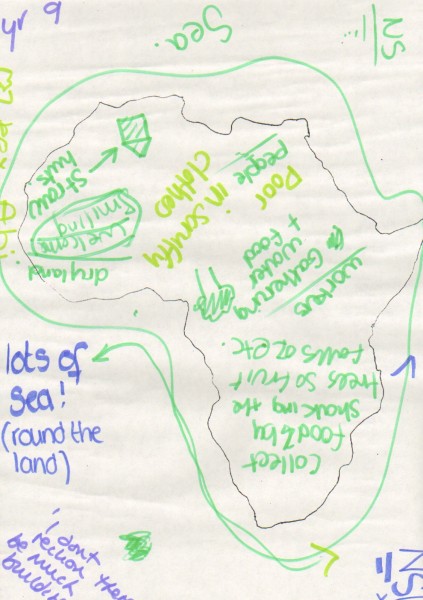About this Collection
What do I want to find out?
To what extent are pupils’ views of countries in Africa stereotypical?
What do I need?
- A blank A3 outline map of Africa for each group
- A question sheet asking If you visited a country in Africa what would you see?
- A pen for each pupil
What do I do?
Timing: 10 minutes
- Ask pupils If you visited a country in Africa what would you see?
- If prompts are needed, these may be useful, but make sure to use the same ones with all pupils:
- ‘Are there any people, what would they be doing, what would they look like?’
- ‘Are there any buildings, what would they look like?’
- ‘What would you see growing?’
- Ask pupils to draw or write their responses on the blank map. Younger pupils may need support with writing down responses; if so record responses yourself or ask colleagues or volunteers to be note takers.
- Record any comments made and explanations given that aren’t written down by pupils.
- Make sure all drawings are labelled as you go, so that they can be easily interpreted later.
How do I analyse the results?
- Classify the comments using the following headings, and if there are multiples of the same comment, then note down how many of each.
Natural Environment
(climate, landscape, animals and plants)
Built Environment
(buildings, any development of land by people)
People and society
(daily life, food, relationships, poverty/wealth, health)
Culture and history
(historical events, monuments, aspects of cultural life, language, music)
Energy, transport and communications
(electricity, technology, transport)
Economic activity
(means of earning income, trade, industry, tourism)
Places (countries, cities, rivers, mountains)
- Notice what the balance is between the different categories, and the diversity of responses within each category. Do pupils have a single image of the continent? Do they only know about rural lives, traditional cultures, wild animals and poverty, or are they aware of the diversity in landscapes, buildings and people?
How do I measure the change?
- Repeat the activity, analyse and compare the results.
- Examine the extent of change with the first activity results
- Look for a greater balance in pupils’ responses, showing an awareness of diversity in all aspects of life in any African country, for example between urban and rural life, rich and poor, traditional and contemporary.
- Look for greater awareness of African authors, artists, musicians, scientists and designers.
- Note any other changes in awareness of issues surrounding the continent of Africa, for example the impact of globalisation on international trade with African countries, or of the effects of climate change.


